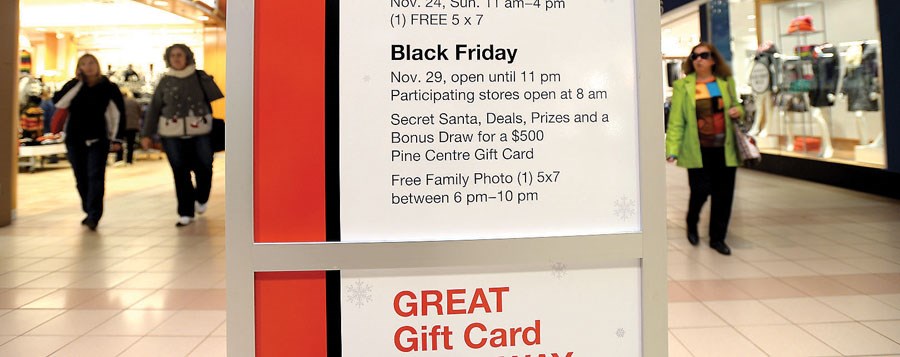After decades of being a consumer phenomenon in the United States, Black Friday is a growing presence in Prince George.
Canadian retailers within easy driving range of the U.S. border have been seeing red over Black Friday, the day after American Thanksgiving, for years. Cross-border shoppers have increasingly gone hunting for amazing deals at stateside stores during the busiest American retail day of the year, leaving their Canadian counterparts with quiet cash registers.
In the past few years, Black Friday has drifted into Prince George, as Canadian retailers, regardless of their distance from the U.S. border, reach out to consumers with great deals of their own.
"It primarily affects our Pine Centre Mall stores and big box retailers," said Chamber of Commerce CEO Christie Ray, who surveyed a sample of local members on the issue of Black Friday. "For the most part, it is not on the radar of small, independent retailers. They may have sales on, but they aren't linked to Black Friday, and it is not a concern for them. But some of our bigger members said they would be definitely embracing the Black Friday event with sales, customer incentives and some said they would even be opening at midnight the night before."
Pine Centre Mall is actively promoting Black Friday as a shopping event this year.
"Black Friday is going to be big. We are doing it for the first time, but we are making a big commitment to it, mall-wide,". said Pine Centre general manager Sonya Hunt. "The mall has the influence of American retailers like Target and Aropostale who take Black Friday very seriously as part of their annual business planning, and that shows up here. It has been there in the past but this year we decided to really support what they were doing. It should be a benefit to all our tenant businesses."
Hunt said the relative parity of the Canadian loonie with the American buck is another factor in any consumer's buying program. It applies to physical cross-border shoppers or the ones at home gleaning cheap deals on the internet.
"E-shopping, online ordering from established retail stores, social media advertising, all these are new influences on the way shopping is done, and it really leaves Canadian retailers everywhere with no choice but to embrace Black Friday as a key time to market themselves," said Hunt. "Times are changing rapidly, we in that industry aren't exactly sure what the effects are going to be, so you have to acknowledge the forces that can take business away from you and participate in ways of marketing yourself, and consider Black Friday as an opportunity."
Ray said continental consumer research is indicating a decline in Boxing Day spending, but an upsurge in Black Friday spending that more than offsets it. People's financial situations are often sketchy in the days following Christmas and people are more sensible now about not taking on debt for common consumer goods.
The history of Black Friday is as complex as its reasons for emerging in northern B.C. According to word origin articles, the term has applied to the day following the American Thanksgiving holiday since the 1950s.
It first emerged as a reference to all the absent employees on the Friday after the holiday, since missing work that day gave employees a four-day long weekend.
When shoppers jammed the streets in the 1960s to cash in on great post-Thanksgiving deals, police in urban centres considered it one of the harshest days on their annual calendar. A Philadelphia newspaper pinned the Black Friday term - already in use for that day of the year - to the traffic difficulties.



